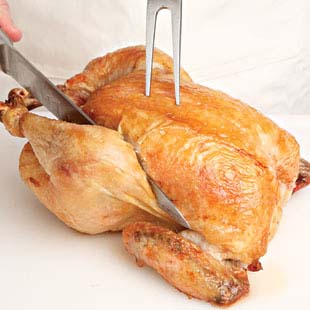
By Ben Hewitt and EatingWell Editors
As consumers demand ever more information about their chicken, producers and government regulators have responded with labels that are supposed to take the mystique out of your bird. Unfortunately, deciphering these labels can make even the most Zen among us feel like a chicken with its head cut off. Here is our guide to truth in poultry labeling.
Free Range
It’s nice to imagine that the chicken on our plate led a life of bucolic splendor. “Free range” certainly implies such an existence—but this USDA-regulated term means only that the birds are granted access to the outdoors. “Generally, this does not mean that the chickens have a large, grassy ‘range,’ but that they are given access to a fenced area outside the chicken house,” explains Richard Lobb, spokesman for the National Chicken Council.
Certified Organic
Stipulations placed on USDA-certified organic producers are many. All feed given to chickens must be certified organic, which means no chemical fertilizers, pesticides, animal by-products or other additives. Certified organic poultry must also meet “free range” criteria. Additionally, federal regulations call for “shelter designed to allow for (i) natural maintenance, comfort behaviors, and opportunity to exercise; (ii) temperature level, ventilation, and air circulation suitable to the species; and (iii) reduction of potential for livestock injury,” but there is no guidance regarding what chickens require in these areas.
Raised Without Antibiotics
This term indicates that the chicken was raised without antibiotics for health maintenance, disease prevention or treatment of disease. Medications not classified as antibiotics may still be used. “Antibiotic-free” is not allowed to be used on labels but may appear in marketing (e.g., websites, etc.). All chicken is “antibiotic-free,” as no antibiotic residues are present in the meat due to the withdrawal periods and other precautions required by the government. (Should you be worried about antibiotics in your meat? Find out here.)
No Hormones
Because hormones are sometimes utilized in beef production, poultry producers are eager to let consumers know that their birds aren’t stepping up to the hormone bar. But since the USDA prohibits the use of hormones in poultry, the label “hormone-free,” while accurate, doesn’t set one chicken apart from another.
Natural
This is one of the most widely used labels, for good reason: it’s pretty darn easy to meet the standards. “Natural” means that no additives or preservatives were introduced after the poultry was processed (although certain sodium-based broths can be added; read the fine print if this is a concern). “Natural” has absolutely nothing to do with standards of care, type and quality of feed or administration of medications.
Percent Retained Water
To control pathogens like Salmonella, producers must quickly lower the temperature of birds during processing. Most do this by immersing the slaughtered chickens in a cold bath, which causes them to absorb water. The USDA requires producers to list the maximum amount of water that may be retained. Some producers “air-chill” their birds, a process that does not result in any retained water.
Certified Humane Raised & Handled
Overseen by a nonprofit endorsed by the American Society for the Prevention of Cruelty to Animals and the Humane Society of the United States, this label ensures your chicken received basic standards of care. For instance, CHRH producers must provide at least six continuous hours of darkness per 24-hour period (many birds live in round-the-clock light to hasten growth). Feed must be fresh. Original guidelines required producers to provide about 1 square foot per chicken; however, this is currently under review. This third-party certification does not have any rules about access to pasture.
Kosher
Recently, The New York Times reported that most people are buying kosher chickens not for religious reasons but because they believe that they’re raised more humanely and are less likely to be contaminated. Kosher laws insist birds be slaughtered with a single cut to the neck using a special razor-sharp blade. The birds are not stunned, as is standard in most operations. However, one shouldn’t assume that all kosher chickens are treated humanely, say some animal-welfare groups. As for the relative food safety of kosher chicken, scientific results have been mixed.
Farm-Raised
The USDA defines a “farm” as any operation that sells at least $1,000 of agricultural commodities, so any producer raising that much chicken to sell is entitled to use this label. It says nothing about how the chickens were raised. It also does not mean that the person overseeing the operation drives a truck or wears faded flannel.
What labels are you most concerned about when you're buying chicken?
By Ben Hewitt and EatingWell Editors
Ben Hewitt is the author of "The Town That Food Saved" (Rodale Books, March 2010)